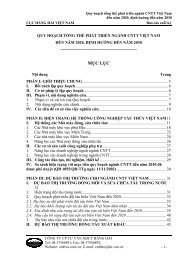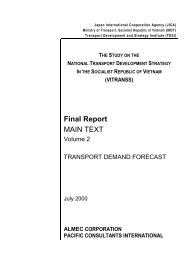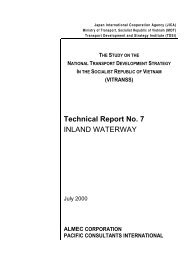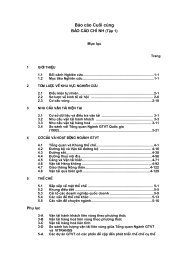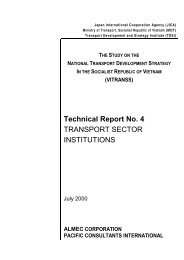Technical Report No. 8 PORT AND SHIPPING
Technical Report No. 8 PORT AND SHIPPING
Technical Report No. 8 PORT AND SHIPPING
Create successful ePaper yourself
Turn your PDF publications into a flip-book with our unique Google optimized e-Paper software.
I-4-6<br />
Vietnam National Transport Strategy Study (VITRANSS)<br />
<strong>Technical</strong> <strong>Report</strong> <strong>No</strong>. 8<br />
Shipping and Ports<br />
Since 1987, however, the shipping industry has been exempted from import<br />
duties and VAT through its inclusion in the IPP, which is issued annually.<br />
Under the 1998 IPP, the interisland shipping industry was included again<br />
(with modernization program) and as a priority investment area, covering<br />
purely cargo or passenger and passenger-cargo vessel operations. For<br />
accredited shipping companies, this means the imposition of a 3% import<br />
duty instead of the regular 20% on imported capital equipment and its<br />
accompanying spare parts.<br />
Accredited/registered firms are also exempt from paying income taxes from<br />
3-6 years, depending on the status of the project. But both international and<br />
domestic shipping companies have to pay 10% VAT on their gross receipts.<br />
4) Tax on seafarers<br />
The Tax Reform Act of 1997, Section 24-(A) (1) (a), considers only as taxable<br />
the income derived by Philippine seafarers within the country. Philippine<br />
seafarers who receive compensation for services rendered abroad as<br />
crewmembers of a vessel engaged exclusively in international trade are<br />
exempt from paying individual income tax.<br />
4.1.4 Japanese Experience on Joint Vessel Ownership<br />
Of the various governmental assistance given to the shipping industry in Japan,<br />
the most noteworthy is the assistance provided through the Corporation for<br />
Advanced Transport and Technology (CATT), formerly known as the Maritime<br />
Credit Corporation. The basic objective of the CATT is centered on the<br />
“contribution to the provision of adequate and smooth shipping and port<br />
transport”. Although the statement is simple and abstract, it aims to promote<br />
social stability and economic growth.<br />
CATT Profile and Scale<br />
Established : June 1959 as the Maritime Credit Corporation and changed to<br />
the Corporation for Advanced Transport and Technology in<br />
October 1997<br />
Capital : Yen 14.9 billion (as of 31March 1999, government-financed)<br />
Staff : 132<br />
Operational budget: Yen 1,245.5 billion (for 1997 fiscal year)<br />
Operating capital : Procured through government loans and privately accepted<br />
bonds<br />
To meet its objective, the CATT has two conditions:<br />
1) Its assistance will be limited to domestic operators who find it difficult<br />
obtaining adequate financing, at the same time can their project’s assure<br />
financial viability, and



